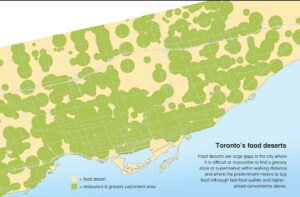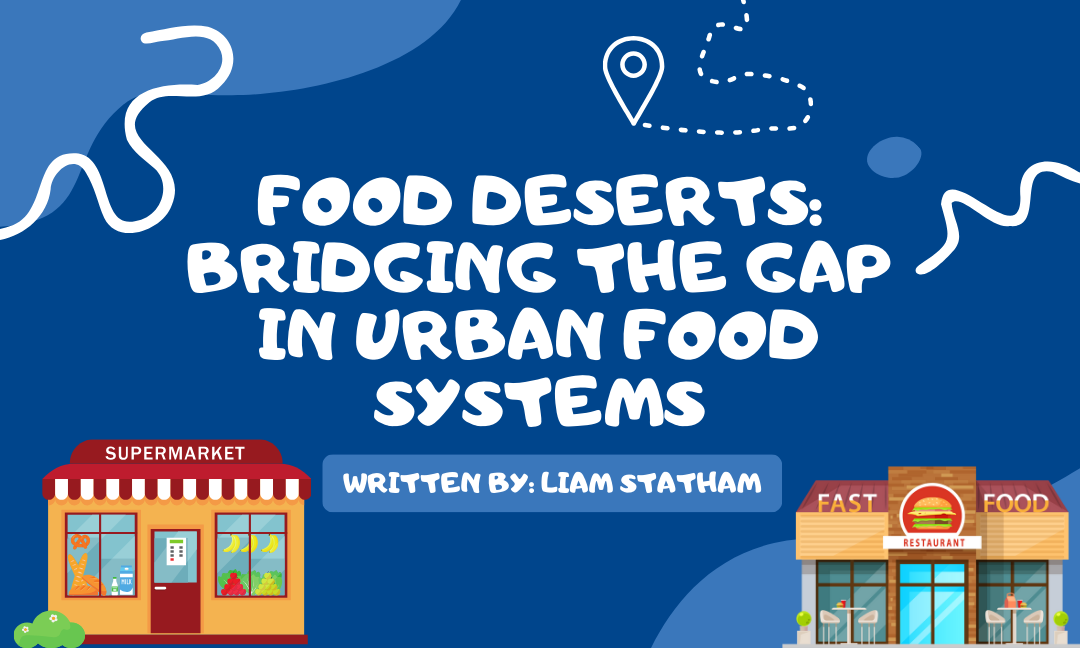Written by Liam Statham
Edited by Koneenika Datta
Designed by Ayesha
Published by Kiritika Rana
 Food deserts are neighbourhoods where residents’ access to affordable and healthy food options is restricted or completely absent due to a lack of grocery stores within a reasonable distance of the neighbourhood. There are many food deserts across Canada, existing in small towns to parts of big cities like Edmonton and Toronto. Food deserts pose a big threat as they can lead to nutritional problems and intergenerational obesity.
Food deserts are neighbourhoods where residents’ access to affordable and healthy food options is restricted or completely absent due to a lack of grocery stores within a reasonable distance of the neighbourhood. There are many food deserts across Canada, existing in small towns to parts of big cities like Edmonton and Toronto. Food deserts pose a big threat as they can lead to nutritional problems and intergenerational obesity.
What are the causes of food deserts?
 Food deserts occur due to various factors. One key reason is the lack of transportation, limiting people’s access to grocery stores. Additionally, food deserts almost always emerge in low-income communities. It is seen that wealthy districts have almost 3 times as many supermarkets as the poor ones. Racial and ethnic disparities also contribute, as predominantly black neighbourhoods are found to have4 times fewer supermarkets than predominantly white neighbourhoods. Finally, urbanisation plays a role as well. In heavily urbanised areas, land is costly so it’s often too expensive for grocery stores (which take up a lot of space) to purchase or lease land.
Food deserts occur due to various factors. One key reason is the lack of transportation, limiting people’s access to grocery stores. Additionally, food deserts almost always emerge in low-income communities. It is seen that wealthy districts have almost 3 times as many supermarkets as the poor ones. Racial and ethnic disparities also contribute, as predominantly black neighbourhoods are found to have4 times fewer supermarkets than predominantly white neighbourhoods. Finally, urbanisation plays a role as well. In heavily urbanised areas, land is costly so it’s often too expensive for grocery stores (which take up a lot of space) to purchase or lease land.
What are the results of food deserts?
 Food deserts are a critical problem in society because they directly lead to poor nutrition and health problems. People living in food deserts are really only presented with two choices, either spend hours making a trek to the nearest grocery store, or go to a fast-food place, which are in abundant supply in these neighbourhoods. Many understandably choose the latter, but consistently eating fast food leads to poor nutrition, and to an increased risk of obesity and related health problems. These health issues tend to be intergenerational, meaning the children of an obese person living in a food desert are more likely to be obese themselves. This creates a cycle where the health disparities continue to grow worse.
Food deserts are a critical problem in society because they directly lead to poor nutrition and health problems. People living in food deserts are really only presented with two choices, either spend hours making a trek to the nearest grocery store, or go to a fast-food place, which are in abundant supply in these neighbourhoods. Many understandably choose the latter, but consistently eating fast food leads to poor nutrition, and to an increased risk of obesity and related health problems. These health issues tend to be intergenerational, meaning the children of an obese person living in a food desert are more likely to be obese themselves. This creates a cycle where the health disparities continue to grow worse.
What are the solutions?
Luckily, there are many solutions at work dedicated to rid the world of food deserts. Several governmental programs have been instituted. For example, tax incentives are offered for grocery stores built within low-income communities. The government is also increasing funding for public transport in an effort to allow easier transportation to food options. The private sector is also getting involved and working towards a food desert solution. For example, mobile grocery stores and food trucks are being brought into communities who need it most.
In conclusion, the issue of food deserts presents a challenge to both individuals and communities, with far-reaching health implications. But by collectively addressing the causes of food deserts and implementing solutions, we can strive for a healthier world for both current and future generations.
Works Cited
(2023, March 20). What are food deserts? 3 solutions to solve them. Eden Green.
Hilario, K. M. (2021, April 13). Food deserts in Canadian cities. ArcGIS StoryMaps.
https://storymaps.arcgis.com/stories/934a49ffcdf347aa8cec1ccde13978c5
Food deserts. Food Empowerment Project. (2023).
https://foodispower.org/access-health/food-deserts/
Food deserts. Canadian Environmental Health Atlas. (n.d.).
https://www.ehatlas.ca/built-environments/food-deserts
Images
Food deserts. Canadian Environmental Health Atlas. (n.d.). Map of food deserts in Toronto
https://www.ehatlas.ca/built-environments/food-deserts
2020, political cartoon about food deserts, Chapman University
https://blogs.chapman.edu/sustainability/2020/08/26/intersectional-issues-food-deserts/
Trimarchi M 2023, South Los Angeles fast food restaurants, HowStuffWorks
https://science.howstuffworks.com/environmental/green-science/food-desert.htm

